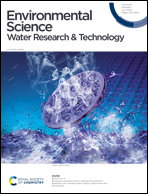QSAR modeling for reaction rate constants of eaq− with diverse organic compounds in water†
Abstract
The hydrated electron (eaq−)-based advanced reduction processes (ARPs) are recognized as a reliable and feasible approach for decontamination of water pollutants. The reaction rate constant (keaq−) of eaq− with organic pollutants is a crucial parameter for assessing their removal efficacy and designing the ARPs. In this work, quantitative structure–activity relationship (QSAR) models for predicting the keaq− values of structurally diverse compounds were developed using both multiple linear regression (MLR) and support vector machine (SVM) methods. The developed models covered a larger dataset (>600 compounds) and exhibited wider applicability domains than existing models, as well as possessing adequate goodness-of-fit (MLR: Rtr2 = 0.712; SVM: Rtr2 = 0.805) and predictability (MLR: Rext2 = 0.816, Qext2 = 0.724; SVM: Rext2 = 0.830, Qext2 = 0.769). Mechanistic analysis revealed that the reactivity of compounds towards eaq− was highly related to energy of the lowest unoccupied molecular orbital (ELUMO), percentage of halogen atoms (X%), the most negative charge on Br atom (qmin,Br) and hardness (η). Additionally, the functional group analysis indicated that the compounds with electron withdrawing groups tended to have increased reactivity towards eaq− compared to those with electron donating groups. The developed QSAR models may serve as a valuable strategy for assessing the removal efficiency and understanding the fate of various pollutants in eaq−-based ARPs.



 Please wait while we load your content...
Please wait while we load your content...